 |
Fort Kugelbake
Cuxhaven, Germany
|
|
 |
Constructed: 1869-1879
Used by: Germany,
Great Britain
Conflicts in which it participated:
None
|
In 1806, Holy Roman Emperor Francis II (1768-1835) had a problem. Since the day that Charlamagne (742?-814) had been crowned King of the Romans in 800AD, the Holy Roman Empire had dominated central Europe through the somewhat loose amalgamation of numerous wee little states, the biggest of which was Germany. And now, it was all on the cusp of being handed over to the Tyrant, Napoleon (1769-1821).
The French had decisively beaten the Austrians at the Battle of Austerlitz in December of 1805, leaving Napoleon free to reorganize the German states as he saw fit. Francis II dissolved the office of Holy Roman Emperor on August 6, 1806, in order to prevent Napoleon from claiming that title, or appointing one of his loser brothers to the throne. |
 |
|
|
What's a long-lived empire to do when cast free of its responsibility to remain as an intact unit? In Germany's case, it works towards unification. Once Napoleon had been disposed of, the Congress of Vienna (1814) founded the German Confederation, which gathered 39 sovereign Germanic states to be ruled by that same Francis who had previously been Holy Roman Emperor Francis II, but who was now ekeing out an only slightly diminished existence as Francis I, King of Austria.
|
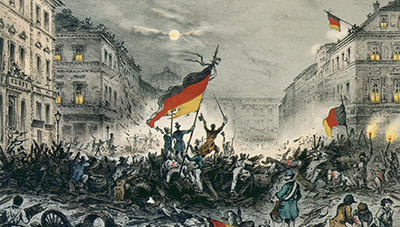 Berlin, 1848. Germany's current flag traces its roots to the flag flown by revolutionaries in a series of anti-Austrian revolts in 1848 and 1849. Note the flags to the right, which more closely resemble the French Tricolor: Some of Germany's rebels at the time favored a Republic based on the French example, and thus modeled their flag accordingly. Berlin, 1848. Germany's current flag traces its roots to the flag flown by revolutionaries in a series of anti-Austrian revolts in 1848 and 1849. Note the flags to the right, which more closely resemble the French Tricolor: Some of Germany's rebels at the time favored a Republic based on the French example, and thus modeled their flag accordingly. |
 |
This all made lots of sense to the Congress of Vienna (which was held in Austria), but ignored the influence that Prussia had gained over those Germanic states. This arrangement led to plenty of trouble down the road, when growing unrest about the Habsburg (Austrian) role in the governance of the German Confederation exploded into the German Revolutions of 1848-49.
The Austro-Prussian War in 1866 saw Austria decisively defeated, and Prussia, led by superstatesperson Otto von Bismarck (1815-1898), proclaimed the North German Confederation in 1867. This joined 22 Germanic states, excluding those southern states still loyal to Austria. |
|
Which brings us to the Germanic situation in 1869, when the polygonal fort of our current interest was born. The mouth of the Elbe River, which grants access to the vastly important harbor of Hamburg (even today, Hamburg is the third-largest port in Europe, after only Rotterdam and Antwerp), had long been recognized as a spot in desperate need of fortification. The Prussian authorities finally got things underway in 1869, and the construction of earthworks was initiated.
|
Our polygonal fort was named after a navigational aid familiar to all mariners who sailed in and out of the Elbe River since the early 18th century: The Kugelbake. A stand of trees at the mouth of the Elbe served as a bearing point for those approaching the river from the North Sea until 1702, when a storm surge swept them away. A strange contrivance, consisting of a ball atop a wooden tower (kugel is circle, bake is beacon), was erected as a new bearing point. A ball? Why not a light? Why not a mirror? But this was something undertaken by Germans, so you know they had extremely sound reasoning behind this ball.
The civilian construction companies contracted to build Fort Kugelbake began laying the fort's foundations on May 28, 1870, and by the autumn of that year the first guns had been emplaced. Money to build Fort Kugelbake suddenly dried up at about the same time, however, as Germany had gone to war.
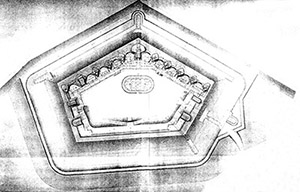 One of the original plans for Fort Kugelbake in 1869 One of the original plans for Fort Kugelbake in 1869 |
 |
All of Germany's frantic confederating and annexing as the Prussian/Austrian power struggle played out had not gone unnoticed. French Emperor Napoleon III (1808-1873) was concerned that the all-important balance of power in Europe had been unduly disrupted. |
|
 |
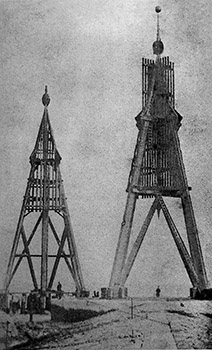 Zwei Kugelbaken! For many years the Kugelbake was made of wood, which necessitated replacement every 30 years or so. Here we see the 1867 Kugelbake (right, which very much resembles today's Kugelbake) just before the 1830's version (left) was taken down. Zwei Kugelbaken! For many years the Kugelbake was made of wood, which necessitated replacement every 30 years or so. Here we see the 1867 Kugelbake (right, which very much resembles today's Kugelbake) just before the 1830's version (left) was taken down. |
|
In the 1850's and 60's Napoleon III had been harrumphing in a significantly meaningful manner at Great Britain, going so far as to suggest that invasion of the British isles might not be such a bad idea. Britain responded with a vast and hugely expensive fort-building program known as the Palmerston Forts ( Fort Monckton and Fort Nelson, both built to protect the shipyards at Portsmouth, are two of the Palmerston Forts). The current Napoleon became distracted by Germanic goings-on in the mid-1860's, however, and Great Britain breathed a sigh of relief as the aspiring Tyrant turned his attention to the east. Which turned out to be a good thing for everybody except France, as Napoleon III launched the Franco-Prussian War by invading Prussia in August of 1870, and by May of the following year France had been comprehensively defeated, with Napoleon III in Prussian custody and the many lovely starforts surrounding Paris occupied by Prussian soldiers. |
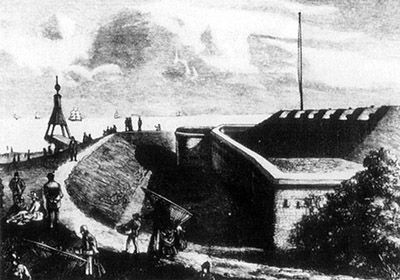 Fort Kugelbake in 1880, with it's namesake visible on the left. Fort Kugelbake in 1880, with it's namesake visible on the left. |
 |
France agreed to pay Germany an indemnity of 5 billion francs, which in today's numbers is somewhere between 450 and 500 billion dollars...and suddenly there was plenty of money to complete Fort Kugelbake, as well as just about anything else Germany felt like building for the next several years!
By 1873 the first iteration of Fort Kugelbake was completed. At this stage of its development the fort had more in common with a coastal battery (küstengeschütz in German, which I include only because it's such a cool word) than a true fort, but great things were still in store for the defensive structure behind the Kugelbake. |
|
Guns were first mounted at Fort Kugelbake in 1870: Enormous 28cm (11 inch!) guns, capable of throwing shells six miles, which was plenty far enough to cover the entire mouth of the Elbe. The fort was considered complete in 1879, and by 1880 'twas armed with ten 28cm guns, with an additional four 12cm (4.72 inch) guns on the left flank of the fort, facing the sea.
|
In the German military at the time, coastal defense works were the responsibility of the navy, not the army: Thus Fort Kugelbake had not a garrison but a crew, of ten officers and 446 men. These coastal defense "sailors" were intended to be "berthed" in the casemates under the guns but, as in just about every other case in which dudes were expected to live in drippy cold casemates, they soon found an excuse to build proper barracks close by.
And these were particularly drippy casemates. Construction of Fort Kugelbake was repeatedly delayed due to the difficulty of building a substantial work in such a mooshy, wet, shifting environment.
|
 |
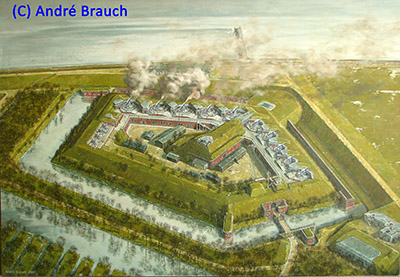 Fort Kugelbake during a firing exercise in 1915, by André Brauch, an artist as talented as he is determined to ensure everyone knows who is responsible for his works. Fort Kugelbake during a firing exercise in 1915, by André Brauch, an artist as talented as he is determined to ensure everyone knows who is responsible for his works. |
|
The Kiel Canal, which joins the Baltic Sea at Kiel-Holtenau with the North Sea at Brunsbüttel, was opened in 1895. Brunsbüttel is just across the Elbe and a smidge south of Fort Kugelbake, which made our polygonal fort even more important to the new German state.
|
|
|
Lots of effort went into sharpening the tip of the spear that was Fort Kugelbake leading up to the First World War (1914-1918): The "world's most powerful spotlight" was installed there in 1909; Water was piped from the nearby city of Cuxhaven in 1910; and a railway line was completed connecting the fort to the city in 1911 for ease of resupply. Yes sir, Fort Kugelbake was completely ready for whatever the Allies might throw at it in the upcoming war!
As it turned out, the Allies threw nothing at the Elbe River during the First World War. Disappointed, Germany transferred five of the fort's 28cm guns to Flanders, where they might actually be used for something, in 1914...which kind of belies that awesome drawing above of a firing exercise in 1915, in which all ten of the fort's guns are in place!
|
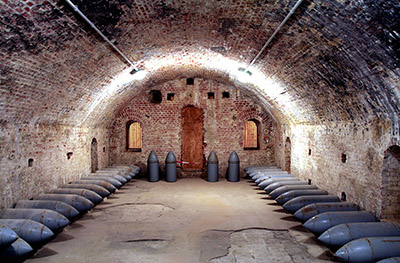 A casemate in Fort Kugelbake, home to a bunch of those big ole 28cm shells! A casemate in Fort Kugelbake, home to a bunch of those big ole 28cm shells! |
 |
Fort Kugelbake was permitted to exist after the war as a coastal defense system under the Treaty of Versailles (1919), albeit at a reduced strength. In 1922 the Hamburg Senate, which was the governing body responsible for Cuxhaven, demanded the razing of Fort Kugelbake, which seemed like an expensive and purposeless edifice. Letting an old fort rot in place is much cheaper than actively dismantling it, however, so happily no action was taken.
8.8cm (3.5-inch) anti-aircraft guns were installed at Fort Kugelbake in 1937, which were upgraded in 1941 with 10.5cm (4.13-inch) guns. During the Second World War (1939-1945) Germany built particularly ugly fortifications all over Europe, and the mouth of the Elbe was no exception. |
|
Several concrete control towers and barracks besmirched the otherwise artful grounds of Fort Kugelbake during this period. And it was perhaps a good thing because on September 4, 1939, a mere three days after Germany's invasion of Poland started the war, British Wellington bombers appeared over Cuxhaven, and were engaged by Fort Kugelbake's guns. Were the bombers shot from the sky, or did they lay waste to Cuxhaven? Apparently some middle ground was found betwixt those two extremes, as neither seems to have happened.
|
Our fort was fully manned throughout the Second World War, with a crew of 350 at the outset, which dwindled to 50 toward the end of the war, comprising 25 German naval aviators and 25 Russian prisoners of war, who were surely totally committed to defending the mouth of the Elbe from Germany's enemies.
Despite frequent visits from Allied fighters and bombers, no enemy naval force ever appeared at the mouth of the Elbe. When the Allies did finally make it to the Elbe/Weser Delta, they did so from the landward side...a side which, you may have noted, Fort Kugelbake wasn't designed to defend itself against. Think those 36cm guns could be turned to defend their rear? I don't.
The British Army took possession of Fort Kugelbake in May of 1945, and for the next few years used the fort as its headquarters for an effort to clear the area of naval mines. Once the military left Fort Kugelbake in 1947, it was used as housing for displaced persons, of whom there were many, and served as a youth hostel until 1967. Local farmers also used the fort as a storage area for their farmer stuff.
|
 |
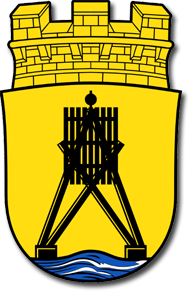 Cuxhaven may love its Kugelbake. This is the city's wappen, or coat of arms. Cuxhaven may love its Kugelbake. This is the city's wappen, or coat of arms. |
|
A restoration program was begun in 1984, in the interest of restoring Fort Kugelbake to its 1910 appearance, when the fort was at the height of its powers. From 1992 to 1994 the fort was restored to the tune of 6.5 million Deutschemarks (around $3.6 million), mostly provided by the European Union. Today Fort Kugelbake exists as the last of Germany's naval coastal defense forts, where outdoor events and concerts are held on a semi-regular basis.
|
|
|
|
|
|
 |




